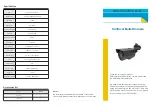
C.4.2 Solvents used to prepare mobile phases
The following solvents and chemicals, which are used commonly to prepare mobile phase, and in
some cases act as sample diluents, are not expected to adversely affect the performance of the
materials shown in the table in
Notes:
• The list of solvents and chemicals and their associated concentrations shown below presents
the levels that have been tested, assessed, or both, for chemical compatibility with the
materials of construction. It is not a recommendation for optimal electrospray sensitivity.
Mobile-phase component concentration affects electrospray efficiency and sensitivity. Keep
modifier and buffer concentrations to the lowest levels that maintain chromatographic
resolution.
• The solvents shown in the table below do not comprise a comprehensive listing. Some
solvents might be chemically compatible with the ACQUITY QDa detector, though they are
not referenced in the lists. Some solvents that are referenced in the lists, but used at higher
concentrations than specified, might also be compatible with the instrument. In such cases,
you must determine the compatibility of the solvents before using them. Where solvents are
used at higher concentrations than specified in the lists, it is important that you determine
whether their use is compatible with the instrument.
Notice:
For LC/MS operation, do not prepare mobile phases using tetrahydrofuran
(THF), and normal-phase solvents like hexane. Such solvents adversely affect the
performance of the materials named in the list of items exposed to solvents (see
), and should not be used. In the event the solvents are used at
reduced concentrations as additives to mobile phases or as sample diluents, you must
evaluate the consequent compatibility issues.
Table C–6: Solvents used to prepare mobile phases (KAB)
Solution
Concentration
Water
100%
Methanol
100%
Acetonitrile
100%
2-Propanol
100%
Formic acid
≤0.1%
Acetic acid
≤0.1%
Trifluoroacetic acid (TFA)
≤0.1%
Ammonium hydroxide
≤0.2%
Ammonium formate
≤10 mM
Ammonium acetate
≤10 mM
Ammonium bicarbonate
≤10 mM
June 15, 2017, 715003956 Rev. F
Page 80
















































